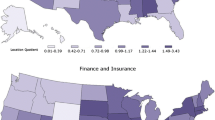Abstract
In this paper, we introduce an entropy spatial model of credit risk contagion in the credit risk transfer (CRT) market that considers the effects of spatial, industry-specific, regional financial and individual factors of the CRT market on credit risk contagion. We use numerical simulation to describe the influence and active mechanism of the spatial distance and transmission capacity between banks and investors in the CRT market. We also assess bank asset quality and credit risk transfer capability, as well as investor asset scale and risk preference level, bank financial development level, investors in the area and the weight of investors in the area relative to credit risk contagion. This model contributes to the explicit formalization of the connection between probability and spatial factors and provides new ideas and a theoretical framework for considering credit risk contagion in a spatial context, which has great relevance for credit risk management.




Similar content being viewed by others
References
Allen, F., & Carletti, E. (2006). Credit risk transfer and contagion. Journal of Monetary Economics, 53, 89–111.
Basso, A., & Barro, D. (2005). Counterparty risk: A credit contagion model for a bank loan portfolio. The ICFAI Journal of Financial Risk Management, 2, 1–24.
Barro, D., & Basso, A. (2010). Credit contagion in a network of firms with spatial interaction. European Journal of Operational Research, 205, 459–468.
Carling, K., & Lundberg, S. (2005). Asymmetric information and distance: An empirical assessment of geographical credit rationing. Journal of Economics and Business, 57, 39–59.
Celik, H. M., & Guldmann, J. M. (2007). Spatial interaction modeling of interregional commodity flows. Socio-Economic Planning Sciences, 41, 147–162.
Chen, T. Q., & He, J. M. (2012a). An evolving network model of credit risk contagion. Working paper, Southeast University.
Chen, T. Q., & He, J. M. (2012b). A network model of credit risk contagion. Discrete Dynamics in Nature and Society, vol. 2012, Article ID 513982, 13 pages. http://dx.doi.org/10.1155/2012/513982
Chen, T. Q., He, J. M., & Wang, J. N. (2013a). Bifurcation and chaotic behavior of credit risk contagion based on FitzHugh-Nagumo system. International Journal of Bifurcation and Chaos, 23, In press.
Chen, T. Q., & He, J. M. (2013b). Dynamics evolution of credit risk contagion in the CRT market. Discrete Dynamics in Nature and Society, vol. 2013, Article ID 206201, 9 pages. http://dx.doi.org/10.1155/2013/206201
Chen, T. Q., & He, J. M. (2013). An entropy spatial interaction model of credit risk contagion in the CRT network. Working paper, Southeast University.
Clarke, G., Langley, R., & Cardwell, W. (1998). Empirical applications of dynamic spatial interaction models. Computational Environmental and Urban Systems, 22, 157–184.
Cossin, D., & Schellhorn, H. (2007). Credit risk in a network economy. Management Science, 53, 1604–1617.
Davis, M., & Lo, V. (2000). Modelling default correlation in bond portfolios. London: Imperial College.
Davis, M., & Lo, V. (2001). Infectious defaults. Quantitive Finance, 1, 382–387.
Egloff, D., Leippold, M., & Vanini, P. (2007). A simple model of credit contagion. Journal of Banking & Finance, 31, 2475–2492.
Focardi, S. M., & Fabozzi, F. J. (2004). A percolation approach to modeling credit risk loss distribution under contagion. Journal of Risk, 7, 75–94.
Frey, R., & Backhaus, J. (2003). Interacting defaults and counterparty risk: A markovian approach. Leipzig: Department of Mathematics, University of Leipzig.
Fujita, M., Krugman, P., & Venables, A. J. (1999). The spatial economy: Cites, regions and international trade. Cambridge: MIT Press.
Giesecke, K. (2004). Correlated default with incomplete information. Journal of Banking and Finance, 28, 1521–1545.
Giesecke, K. (2006). Default and information. Journal of Economic Dynamics and Control, 30, 2281–2303.
Gordon, I. (2010). Entropy, variety, economics, and spatial interaction. Geographical Analysis, 42, 446–471.
Haworth, H., & Reisinger, C. (2006). Modeling basket credit default swaps with default contagion. Working paper, Oxford University.
Haworth, H., Reisinger, C., & Shaw, W. (2008). Modelling bonds and credit default swaps using a structural model with contagion. Quantitative Finance, 8, 669–680.
Jarrow, R. A., & Yu, F. (2001). Counterparty risk and the pricing of defaultable securities. Journal of Finance, 56, 1765–1799.
Jorion, P., & Zhang, G. (2009). Credit contagion from counterparty risk. The Journal of Finance, 64, 2053–2087.
Kchia, Y., & Larsson, M. (2011). Credit contagion and risk management with multiple non-ordered defaults. Working paper, Ecole Polytechnique and Cornell University.
Kodres, L., & Pritsker, M. (2002). A rational expectations model of financial contagion. Journal of Finance, 57, 769–799.
Krugman, P. (1997). Development, geography and economic theory. Cambridge: MIT Press.
Martin, D., & Marrison, C. (2007). Credit risk contagion. Risk, 4, 90–94.
Neu, K., & Kuehn, R. (2004). Credit risk enhancement in a network of interdependent firms. Physica A, 342, 639C655.
O’Kelly, M. E. (2010). Entropy-based spatial interaction models for trip distribution. Geographical Analysis, 42, 472–487.
Santos, T. (2006). Comment on: Credit risk transfer and contagion. Journal of Monetary Economics, 53, 113–121.
Wilson, A. G. (1970). Entropy in urban and regional modelling. London: Pion Limited.
Wilson, A. (2010). Entropy in urban and regional modelling: Retrospect and prospect. Geographical Analysis, 42, 364–394.
Acknowledgments
We wish to express our gratitude to the referees for their invaluable comments. This study was supported by the National Natural Science Foundation of China (Nos. 71173098, 71271109, and 71301078), China Postdoctoral Science Foundation (2014M561626), the Philosophy and Social Sciences Research Funded Projects in Colleges and Universities of Jiangsu (2014SJB081).
Author information
Authors and Affiliations
Corresponding author
Rights and permissions
About this article
Cite this article
Chen, T., Li, X. & Wang, J. Spatial Interaction Model of Credit Risk Contagion in the CRT Market. Comput Econ 46, 519–537 (2015). https://doi.org/10.1007/s10614-014-9475-2
Accepted:
Published:
Issue Date:
DOI: https://doi.org/10.1007/s10614-014-9475-2




